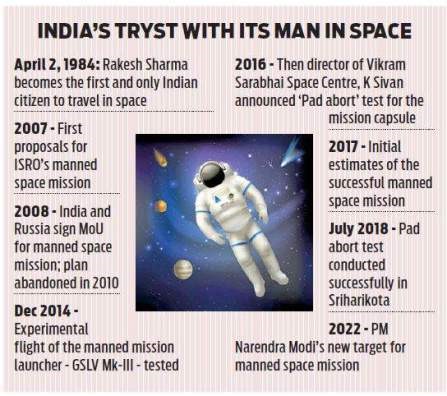What is the issue?
- A Russian rocket launch recently failed but both astronauts on board survived the failure.
- With it's preparations for a manned space mission, India must look into the measures on astronaut safety.
What happened?
- The Russian rocket Soyuz FG was on an expedition to the International Space Station.
- The failure of the rocket led to the abortion of this Expedition.
- On board the Soyuz MS 10 mission were Alexey Ovchinin of Roscosmos and Nick Hague of NASA.
- The failure was detected at an altitude of 50 km.
- So an emergency operation was carried out to separate the crew module.
- The astronauts landed on Earth some 402 km from the launch site at the Russian Baikonur cosmodrome.
- It was the first mid-flight failure of a Soyuz rocket since 1975.
- In 1975, a mission was aborted after the second stage failed to fire while it was climbing to leave Earth’s atmosphere, with crew on board.
What is the significance?
- The first successful human space flight in 1961 was by Yuri Gagarin.
- Since then, 18 astronauts (13 Americans, 4 Russians, 1 Israeli) have lost their lives on space missions.
- The rocket, the crew module and all systems involved require a “human ratings certification” before they can be used to send a human into space.
- The failure of Russian rocket launch has come as a reminder of the perils and technological challenges involved in every space flight.
- The survival of the astronauts on board has been hailed as an example that underlines the safety measures that were in place.
- India - The ISRO is preparing to become the 4th country to launch a human into space (after Russia, the US and China).
- In this line, ISRO's Gaganyaan mission is given the 2022 deadline.
- The focus is now moving from a mission-critical nature to a safety-critical launch nature of rockets.
What are the NASA safety guidelines?
- A NASA manual on human ratings of space systems is available in the public domain.
- It underlines the difference between the development of systems for human space flights and missions with robotic payloads.
- A human-rated system -
- accommodates human needs
- effectively utilizes human capabilities
- controls hazards and manages safety risk associated with human spaceflight
- provides, to the maximum extent practical, the capability to safely recover the crew from hazardous situations
- While designing a rocket to launch any mechanical payload, scientists do not have to consider factors like -
- the amount of heat generated
- vibration caused
- metallic changes in the payload capsule
- But for rockets meant to carry humans, all these factors will have to be brought within human tolerance levels.
- The rocket has to be designed to 25% above the worst case of the expected load in the case of a satellite launcher.
- For a human-rated launcher, it has to be designed 40% above the worst-case loads.
- This is difficult and challenging to do without making the rocket really heavy.

How is GSLV in this regard?
- ISRO’s GSLV Mk III has undergone one experimental and one developmental flight.
- It is expected to make 10 flights, including two in the form of an unmanned human space launch vehicle.
- It is set to finally launch humans in 2022.
- The GSLV Mk III was designed in the 2000-2002 time-frame, to ultimately become a vehicle that takes a human to space.
- So it was designed keeping in mind human flight in the future and may not need any major tweaking.
- The design conditions were kept in such a way that acceleration, reliability, safety, vibration and other aspects are all addressed right at the design stage.
- But, instrumentation and processing required to abort a mission without causing damage to the crew are being looked into.
What should India do?
- India needs to build safety critical features into rockets.
- The crew escape system is crucial to the human space mission.
- The principle here is that there can be a less reliable rocket but a highly reliable crew escape system.
- The most important part of a human space flight is the ability to detect an imminent danger and take action to abort the mission.
- India needs to have systems for this and onboard intelligence required, to see what is happening around and take action if anomalies develop.
Source: Indian Express
